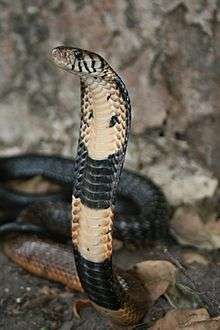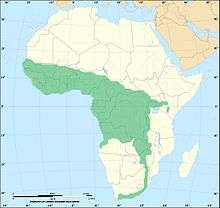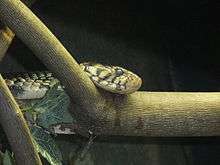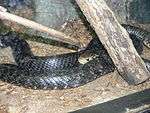Forest cobra
The forest cobra (Naja melanoleuca), also commonly called the black cobra and the black and white-lipped cobra,[3] is a species of venomous snake in the family Elapidae. The species is native to Africa, mostly the central and western parts of the continent.[4] It is the largest true cobra species with the a record length of 3.2 metres (10 feet)[5][6] Although it prefers lowland forest and moist savanna habitats, this cobra is highly adaptable and can be found in drier climates within its geographical range. It is a very capable swimmer and is often considered to be semi-aquatic.[7] The forest cobra is a generalist in its feeding habits, having a highly varied diet: anything from large insects to small mammals and other reptiles.[3] This species is alert, nervous and is considered to be a very dangerous snake.[7][8] When cornered or molested, it will assume the typical cobra warning posture by raising its fore body off the ground, spreading a narrow hood, and hissing loudly. Bites to humans are less common than from other African cobras due to various factors, though a bite from this species is a life-threatening emergency.[9]
| Forest cobra | |
|---|---|
 | |
| Scientific classification | |
| Kingdom: | Animalia |
| Phylum: | Chordata |
| Class: | Reptilia |
| Order: | Squamata |
| Suborder: | Serpentes |
| Family: | Elapidae |
| Genus: | Naja |
| Species: | N. melanoleuca |
| Binomial name | |
| Naja melanoleuca | |
 | |
| Forest cobra distribution in green | |
| Synonyms[1] | |
| |
Taxonomy and evolution
The forest cobra is classified in the genus Naja of the family Elapidae. Naja melanoleuca was first described by American herpetologist Edward Hallowell in 1857.[2][10] The generic name Naja is a Latinisation of the Sanskrit word nāgá (नाग) meaning "cobra".[11] The specific epithet melanoleuca is Ancient Greek and means "of black and white". The word melano is Greek for "black",[12] while leuca comes from the Ancient Greek word for "white".[13] This species is also known as the black cobra and black and white-lipped cobra.[3]
The forest cobra is classified under the genus Naja of the family Elapidae. The genus was first described by Josephus Nicolaus Laurenti in 1768.[14] The species Naja melanoleuca was first described by Edward Hallowell in 1857.[2] The genus Naja was split into several subgenera based on various factors, including morphology, diet, and habitat. Naja melanoleuca is part of the subgenus Boulengerina, along with three other species: Naja annulata, Naja christyi, and Naja multifasciata. The subgenus is united by their restriction to central and west African forest and/or forest-edge type habitat. They are also more aquatic and feed more on aquatic species. The species of the subgenus Boulengerina show great diversity in size, however, ranging from the forest cobra (Naja melanoleuca) which can attain lengths of 2.7 metres (8.9 feet) to the burrowing cobra (Naja multifasciata) which doesn't grow larger than 0.8 metres (2.6 feet) in length. The below cladogram illustrates the taxonomy and relationships among species of Naja:[15]
| Naja |
| ||||||||||||||||||||||||||||||||||||||||||||||||||||||||||||||||||||||||||||||||||||||||||||||||||||||||||||||||||||||||||||||
The population on São Tomé was recently described as a new species, N. peroescobari,[16] and a recent study based on mitochondrial DNA suggests that the N. melanoleuca may actually be made up of as many as five separate species:[17]
- Naja melanoleuca Hallowell 1857 - central African forests: Benin, Nigeria, Cameroon, Central African Republic, Gabon, Democratic Republic of Congo, Republic of Congo, Angola.
- Naja subfulva Laurent, 1955 - forests and savanna woodlands in eastern, southern and central Africa: Chad, Nigeria, Cameroon, Central African Republic, Democratic Republic of Congo, Republic of Congo, Rwanda, Burundi, Uganda, Kenya, Tanzania, Somalia, South Sudan, Ethiopia, Mozambique, Malawi, Zambia, Zimbabwe, South Africa, Angola
- Naja peroescobari Ceríaco et al. 2017 - São Tomé.
- Naja guineensis Broadley et al. in Wüster et al. 2018 - Upper Guinea forests of West Africa: Guinea-Bissau, Guinea, Liberia, Sierra Leone, Ivory Coast, Ghana, Togo.
- Naja savannula Broadley et al. in Wüster et al. 2018 - Savanna regions of West Africa: Senegal, Gambia, Guinea, Liberia, Sierra Leone, Ivory Coast, Ghana, Togo, Benin, Mali, Burkina Faso, Nigeria, Niger, Chad, Cameroon.
Description
The forest cobra is Africa's largest cobra of the genus Naja[7] and possibly the largest of all the true cobra (Naja) species in the world.[6][18] The length of an average adult is 1.4 to 2.2 m (4.6 to 7.2 ft), and they regularly attain lengths of 2.7 metres (8.9 feet),[7] [19] and lengths up to 3.2 metres (10 feet) have been recorded in the wild (Villiers, 1975).[5] Males and females grow to be similar in length, as there is no sexual dimorphism within this species.[20] The head of this snake is large, broad, flattened and is slightly distinct from the neck. It is a slightly depressed, tapered and moderately thick bodied snake with a slender tail that is medium in length. The body is compressed dorsoventrally (where the dorsal upper scales and the ventral lower scales meet at either side of the body) and sub-cylindrical posteriorly (the tail end of the body). The forest cobra has long cervical ribs capable of expansion to form a long, wedge shaped hood when threatened. The angle between the crown of the head and the side of the head between the eye, also known as the canthus is distinct, while the snout is rounded. Its eyes are large with round pupils.[19]
Scalation
Like other snake species, the forest cobra has skin covered in scales. Snakes are entirely covered with scales or scutes of various shapes and sizes, known as snake skin as a whole. Scales protect the body of the snake, aid it in locomotion, allow moisture to be retained within, and alter the surface characteristics such as roughness to aid in camouflage. The dorsal scales of the forest cobra are smooth, glossy and strongly oblique.[3] The colour of this species is variable, with three main colour morphs. Those from the forest or forest fringe, from Sierra Leone east to western Kenya and south to Angola are glossy black, the chin, throat and anterior region of the belly are cream or white, with broad black cross-bars and blotches. The sides of the head are strikingly marked with black and white, giving the impression of vertical black and white bars on the lips. The second colour morph, from the west African savanna, is banded black and yellow, with a black tail, the head is brownish-yellow on top, the lips, chin and throat are yellow. The third colour morph, from the coastal plain of east Africa, south to KwaZulu-Natal, inland to Zambia and southern Democratic Republic of Congo, is brownish or blackish-brown above, paler below, the belly is yellow or cream, heavily speckled with brown or black, and specimens from the southern part of its range have black tails. Melanistic (all black) specimens have been documented from west Africa.[21]
The head, body and tail scalation of the forest cobra:[21]
|
|
Venom
The venom of this cobra is a postsynaptic neurotoxin and bites result in severe neurotoxicity.[9] Ernst and Zug et al. 1996 list a value of 0.225 mg/kg SC.[22] According to Brown and Fry of the Australian Venom and Toxin Database, the murine intraperitoneal LD50 value is 0.324 mg/kg.[23][24] The average venom yield per bite is 571 mg and the maximum venom yield is 1102 mg.[25] This snake can be highly dangerous due to the quantity of venom it can inject in a single bite and its aggressive nature when defending. Death can occur rapidly, within 30 to 120 minutes in severe cases of envenomation. Signs and symptoms of envenomation include ptosis, drowsiness, limb paralysis, hearing loss, inability to speak, dizziness, ataxia, shock, hypotension, abdominal pain, fever, pallor, and other neurological and respiratory symptoms.[9]
The forest cobra is one of the least frequent causes of snake bite among the African cobras,[9] largely due its forest-dwelling habits but a bite by this species should be taken very seriously because it ranks as the 4th most venomous Naja (True Cobra) species. The symptomology is thought to be very similar to that of the Egyptian cobra (Naja haje).[26] Clinical experience with this species has been very sparse, and few recorded bites have been documented. Deaths from respiratory failure due to severe neurotoxicity have been reported, but most victims will survive if prompt administration of antivenom is undertaken as soon as clinical signs of envenomation have been noted. Rare cases of spontaneous recoveries without the use of specific antivenom have also been seen; however, neglecting the use of antivenom places the patient at increased risk for major morbidity and mortality. If the snake becomes cornered or is agitated, it can quickly attack the aggressor, and because a large amount of venom is injected, a rapidly fatal outcome is possible. The mortality rate of an untreated bite is not exactly known but it is thought to be quite high. The forest cobra does not spit or spray its venom. This species is considered to be among the most intelligent of the African elapids by herpetologists.[26]
Two cases from Liberia experienced severe neurological symptoms, including ptosis, nausea, vomiting, tachycardia, and respiratory distress. A child in Ghana died within 20 minutes after being bitten by a snake suspected to be from this species.[27]
Distribution and habitat
The forest cobra occurs mainly in western and central Africa.[3] It is found from Senegal, Guinea-Bissau, Guinea, southeastern Mali, Sierra Leone, Liberia, Côte d'Ivoire, Burkina Faso, Ghana, Togo, Benin, Nigeria, Equatorial Guinea, Cameroon, and Gabon in western Africa to the Republic of Congo, the Democratic Republic of Congo, Central African Republic, and northern Angola in central Africa to western Kenya, Uganda, Rwanda, and Burundi in eastern Africa, and to fragmented parts of southern Africa, including the Natal.[21]

A snake of forest or woodland, it is the only one of Africa's cobras that will live in high forest.[28] The forest cobras are snakes that are well adapted to many environments and the habitat of the forest cobra is strongly dependent on what part of its African range the snake originates from. Forest cobras originating in the southern African regions are typically found in savanna and grassland, but they can also be found in broken rock country. They are mainly found in the tropical and subtropical rainforest regions of west and central Africa.[4] It also inhabits mangroves in western Africa. The banded form of forest cobra in west Africa lives in savanna and grassland (but usually along streams) and well vegetated areas, especially riverine forest, up to latitude 14 N. The species' preferred habitat are lowland forest and moist savanna where it favours coastal thickets.[21] This snake seems to be highly adaptable and will readily move into drier areas if it can. In western Kenya, the forest cobra has been found in wide stretched grassland areas.[28] The population of forest cobras in Uganda are almost always found close to water. The brown colour phase occurs in coastal and high altitude forest, woodland and thicket, and grassland areas (i.e. Nyanga, Zimbabwe). Due to its secretive habits, and fondness for living in holes, it often persists in quite well-inhabited areas, common in and around many central African towns, even long after most vegetation has gone. They are also found on fruit plantations where they live in the trees. It occurs through a wide altitude range, from sea-level to forested mountains at 2,800 metres (9,200 feet) above sea-level.[28]
Behavior

The forest cobra is an agile, diurnal species that climbs well and is one of the most aquatic of the true cobras of the genus Naja.[7] It is terrestrial, but it is a fast, graceful climber, known to ascend trees to a height of 10 metres (33 feet) or more. It is quick moving and alert. It swims well and readily takes to the water; in some areas its main diet is fish and could be regarded as semi-aquatic. Although it is active mostly during the day (diurnal) in uninhabited areas, it can also be active by night (nocturnal) where it goes into urban areas. When not active, it takes cover in holes, brush piles, hollow logs, among root clusters or in rock crevices, or in abandoned termite mounds at forest fringe or clearings. In certain areas, it hides along river banks, in overhanging root systems or bird holes, and in urban areas will hide in junk piles or unused buildings. When agitated, it rears up to a considerable height and spreads a long, narrow hood. It can strike quickly, to quite a long distance, and if molested and cornered, it will rush forward and make a determined effort to bite. It is an alert and agile species of cobra.[26] Some authorities believe it is one of the most dangerous African snakes to be kept as many captive forest cobras are described to be particularly aggressive when handled.[7][8] This species is not able to "spit" its venom.[21]
Diet
Forest cobras will feed on a wide variety of prey,[3] including amphibians, fish, other snakes, monitor lizards and other lizards, bird eggs, rodents, and other small mammals. It has been recorded as taking mudskippers, and in west Africa, one specimen had eaten a Gifford's giant shrew, an insectivore with a smell so noxious, most other snakes would not touch it.[26]
Reproduction
.jpg)
This is an oviparous species.[7] In the summer, females will lay between 11 and 26 smooth white eggs, each roughly 30 to 60 millimetres (1.2 to 2.4 inches). The eggs stick together in a bunch.[21] The eggs are laid in hollow trees, termite mounds, holes in the ground or females will make their own nests. Before mating, a pair of will "dance", raising their heads a foot or more off the ground and moving to and fro. This may continue for an hour before mating takes place, when the male presses his cloaca (the chamber into which the reproductive, urinary, and intestinal canals empty) against that of the female. Female forest cobras may stand guard and are irritable and aggressive during the breeding period. A female is liable to attack without provocation, with potentially fatal consequences for passers-by if her nest is near a footpath.[6] Hatchlings are born completely independent and are usually 22 to 25 centimetres (8.7 to 9.8 inches) in length.[19] Although some sources claim that hatchlings may measure up to 47 centimetres (19 inches)[21] Incubation period is anywhere from 55 to 70 days (or over 80 days in one captive study[29]) at temperatures of 27–30 °C (81–86 °F). These snakes are known to have a long lifespan. One captive specimen lived for 28 years, which is the record for the longest lived venomous snake in captivity.[28] Another specimen held at the Melbourne Zoo in Australia turned 35 on September 1, 2014.[30]
References
- "Naja melanoleuca". Encyclopedia of Life. Retrieved 22 March 2014.
- "Naja melanoleuca". Integrated Taxonomic Information System. Retrieved 11 January 2014.
- "Naja melanoleuca". Clinical Toxinology Resource. University of Adelaide. Retrieved 22 March 2014.
- Mattison, C. (2007). The New Encyclopedia of Snakes. New York City: Princeton University Press. p. 272. ISBN 978-0-691-13295-2.
- Chippaux, JP; Jackson, K (18 June 2019). Snakes of Central and Western Africa (1 ed.). 128: Johns Hopkins University Press. p. 128. ISBN 978-1421427195.CS1 maint: location (link)
- Burton, M. (2002). International Wildlife Encyclopedia. United States: Marshall Cavendish Corp; 3rd edition. pp. 481–482. ISBN 0-7614-7270-3.
- O'Shea, M. (2005). Venomous Snakes of the World. United Kingdom: New Holland Publishers. p. 71. ISBN 0-691-12436-1.
- Haji, R. "Venomous snakes and snake bite" (PDF). Zoocheck Canada Inc. p. 14. Archived from the original (PDF) on 25 April 2012. Retrieved 27 February 2012.
- "Immediate First Aid for bites by the Forest cobra (Naja melanoleuca)". Toxicology. University of California, San Diego. Retrieved 22 March 2014.
Clinical experience with Naja melanoleuca has been very sparse, and few recorded bites have been documented.
- Hallowell, Edward (1857). "Notice of a collection of Reptiles from the Gaboon country, West Africa, recently presented to the Academy of Natural Sciences of Philadelphia, by Dr. Henry A. Ford". Proceedings of the Academy of Natural Sciences of Philadelphia 9: 48–72. (Naja haje var. melanoleuca, new variation, pp. 61-62).
- "Naja". The Free Dictionary. Princeton University. Retrieved 10 January 2014.
- "melano". Merriam-Webster Medical Dictionary. Retrieved 10 March 2014.
- "leuc-". Merriam-Webster Medical Dictionary. Retrieved 10 March 2014.
- "Naja". Integrated Taxonomic Information System. Retrieved 11 January 2014.
- Wallach, Van; Wüster, Wolfgang; Broadley, Donald G. (2009). "In praise of subgenera: taxonomic status of cobras of the genus Naja Laurenti (Serpentes: Elapidae)" (PDF). Zootaxa. 2236: 26–36. doi:10.11646/zootaxa.2236.1.2. Retrieved 11 January 2014.
- Ceríaco, Luis M.P.; et al. (2017). "The "Cobra-preta" of São Tomé Island, Gulf of Guinea, is a new species of Naja Laurenti, 1768 (Squamata: Elapidae)". Zootaxa. 4324 (1): 121–141. doi:10.11646/zootaxa.4324.1.7. ISSN 1175-5334.
- Wüster, Wolfgang; et al. (2018). "Integration of nuclear and mitochondrial gene sequences and morphology reveals unexpected diversity in the forest cobra (Naja melanoleuca) species complex in Central and West Africa (Serpentes: Elapidae)". Zootaxa. 4455 (1): 68–98. doi:10.11646/zootaxa.4455.1.3. ISSN 1175-5334. PMID 30314221.
- Broadley, DG. (1983). Fitzsimons' Snakes of Southern Africa. Johannesburg: Delta Books. ISBN 0-947464-30-1.
- Spawls, Stephen; Branch, Bill (1995). The Dangerous Snakes of Africa (revised ed.). Ralph Curtis. p. 71. ISBN 978-0-88359-029-4.
- Shine, R.; Branch, W. R.; Webb, J. K.; Harlow, P. S.; Shine, T.; Keogh, J. S. (June 2007). "Ecology of cobras from southern Africa". Journal of Zoology. 272 (2): 183–193. doi:10.1111/j.1469-7998.2006.00252.x.
- Marais, J. (1992). A Complete Guide to Snakes of Southern Africa (Republished 2004). South Africa: Struik Publishers. p. 312. ISBN 1-86872-932-X.
- Zug, G.R.; Ernst, C.H. (1996). Snakes in Question: The Smithsonian Answer Book. Washington D.C., USA: Smithsonian Institution Scholarly Press. p. 112. ISBN 1-56098-648-4.
- Brown, JH (1973). Toxicology and Pharmacology of Venoms from Poisonous Snakes. Springfield, IL: Thomas. p. 184. ISBN 0-398-02808-7. LCCN 73000229.
- Fry, BG. "LD50 menu (Archived)". Archived from the original on 13 April 2012. Retrieved 22 March 2014.
- Mirtschin, Peter J.; Dunstan, Nathan; Hough, Ben; Hamilton, Ewan; Klein, Sharna; Lucas, Jonathan; Millar, David; Madaras, Frank; Nias, Timothy (26 August 2006). "Venom yields from Australian and some other species of snakes" (PDF). Ecotoxicology. 15 (6): 531–538. doi:10.1007/s10646-006-0089-x. PMID 16937075. Retrieved 6 November 2013.
- Spawls, Stephen; Branch, Bill (1995). The Dangerous Snakes of Africa (revised ed.). Ralph Curtis. p. 73. ISBN 978-0-88359-029-4.
- Spawls, S.; Ashe, J.; Howell, K.; Drewes, R. (2002). A Field Guide To The Reptiles Of East Africa. London: Academic Press. p. 543. ISBN 978-0-12-656470-9.
- Spawls, Stephen; Branch, Bill (1995). The Dangerous Snakes of Africa (revised ed.). Ralph Curtis. p. 72. ISBN 978-0-88359-029-4.
- Tryon, BW. (15 November 1979). "Reproduction in Captive Forest Cobras, Naja melanoleuca (Serpentes: Elapidae)". Journal of Herpetology. Society for the Study of Amphibians and Reptiles. 13 (4): 499–504. doi:10.2307/1563487. JSTOR 1563487.
- "Rare Reptile Reaches Milestone". Zoos Victoria. 1 September 2014. Archived from the original on 27 November 2015. Retrieved 5 September 2014.
| Wikispecies has information related to Naja melanoleuca |
External links
- Immediate First Aid for bites by Forest cobra (Naja melanoleuca)
- Clinical Toxinology Resource
- Forest cobra (N. melanoleuca)
![]()